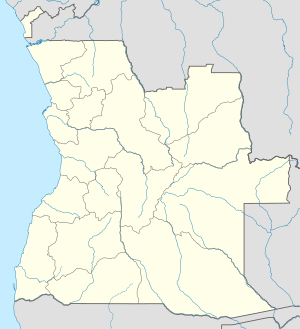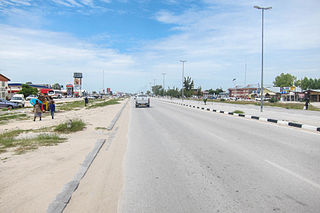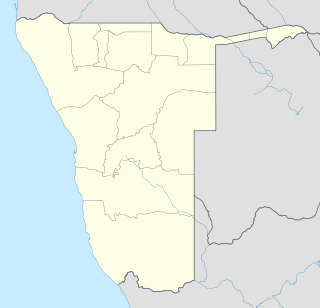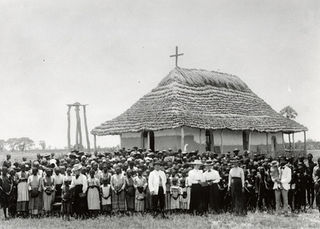Omupanda | |
|---|---|
village | |
| Coordinates: 17°04′S15°44′E / 17.067°S 15.733°E | |
| Country | |
| Province | Cunene Province |
| Elevation | 1,120 m (3,670 ft) |
| Time zone | UTC+1 (WAT) |
| Climate | Cwa |
Omupanda was a mission station of the Rhenish Mission Society in Oukwanyama in southern Angola, located 10 km to the south-east of Ondjiva.
Oukwanyama is a traditional kingdom of the Ovambo people in what is today northern Namibia and southern Angola. Its capital is Ehole.

Angola, officially the Republic of Angola, is a west-coast country of south-central Africa. It is the seventh-largest country in Africa, bordered by Namibia to the south, the Democratic Republic of the Congo to the north, Zambia to the east, and the Atlantic Ocean to the west. Angola has an exclave province, the province of Cabinda that borders the Republic of the Congo and the Democratic Republic of the Congo. The capital and largest city of Angola is Luanda.
The kilometre, or kilometer is a unit of length in the metric system, equal to one thousand metres. It is now the measurement unit used officially for expressing distances between geographical places on land in most of the world; notable exceptions are the United States and the road network of the United Kingdom where the statute mile is the official unit used.
Omupanda was founded in 1892 by German missionary August Wulfhorst. At the time, it was thought that the area was part of German South West Africa.

Germany, officially the Federal Republic of Germany, is a country in Central and Western Europe, lying between the Baltic and North Seas to the north, and the Alps, Lake Constance and the High Rhine to the south. It borders Denmark to the north, Poland and the Czech Republic to the east, Austria and Switzerland to the south, France to the southwest, and Luxembourg, Belgium and the Netherlands to the west.

A missionary is a member of a religious group sent into an area to proselytize or perform ministries of service, such as education, literacy, social justice, health care, and economic development. The word "mission" originates from 1598 when the Jesuits sent members abroad, derived from the Latin missionem, meaning "act of sending" or mittere, meaning "to send". The word was used in light of its biblical usage; in the Latin translation of the Bible, Christ uses the word when sending the disciples to preach The gospel in his name. The term is most commonly used for Christian missions, but can be used for any creed or ideology.

German South West Africa was a colony of the German Empire from 1884 until 1919. With an area of 835,100 km², it was one and a half times the size of the mainland German Empire in Europe at the time. The colony had a population of around 2,600 Germans.
Just as the first building was completed, it burned down and had to be rebuilt.
In 1900, the German missionary Hermann Tönjes came to Omupanda, together with his newly wed wife Anna (née Rautanen), daughter of the Finnish missionary Martti Rautanen.

Martti (Martin) Rautanen was the pioneer of the Finnish Mission in Ovamboland, Namibia.
The Germans had to leave Angola in 1916 as a result of World War I, and thus Omupanda was left empty. In 1928, the mission was transferred to the Catholic Church, and it remains Catholic to this day. [1]

World War I, also known as the First World War or the Great War, was a global war originating in Europe that lasted from 28 July 1914 to 11 November 1918. Contemporaneously described as "the war to end all wars", it led to the mobilisation of more than 70 million military personnel, including 60 million Europeans, making it one of the largest wars in history. It is also one of the deadliest conflicts in history, with an estimated nine million combatants and seven million civilian deaths as a direct result of the war, while resulting genocides and the 1918 influenza pandemic caused another 50 to 100 million deaths worldwide.

The Catholic Church, also known as the Roman Catholic Church, is the largest Christian church, with approximately 1.3 billion baptised Catholics worldwide as of 2017. As the world's "oldest continuously functioning international institution", it has played a prominent role in the history and development of Western civilisation. The church is headed by the Bishop of Rome, known as the pope. Its central administration, the Holy See, is in the Vatican City, an enclave within the city of Rome in Italy.





